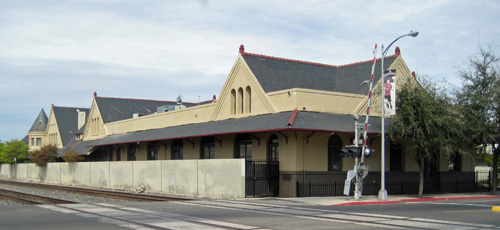
Southern Pacific Railroad Depot (1889)
1713 Tulare Street
Queen Anne
Description
The Southern Pacific Railroad Depot at Tulare and H Streets in downtown Fresno is an unusual departure from the traditional Southern Pacific architectural style. Evidence suggests that citizens of Fresno in 1888 rejected the original plans for the depot, which may explain why it was not constructed in the rectangular box style prevalent throughout the rest of the San Joaquin Valley.
In 1889 construction began on a depot to replace the small wooden structure that had served the community since 1872. It was constructed entirely of brick and topped with a slate bellcast hip roof, with approximate dimensions of 60' x 150'. The ground floor windows were primarily straight-topped with small-paned top sashes over solid glass lower halves. Continuity of the ground floor was broken only by two turrets, one ground level and one extending from roof to main level. The building was asymmetrical with its cross gable set off center; a round turret adjoined this gable on track side. Three round-arched, small-paned windows with brick detailing decorated the gable, while straight-topped, small-paned windows along with a Queen Anne cornice detailing adorned the turret. A single dormer was located on the north end of the street side.
A major addition was added sometime between 1914 and 1929. Additional freight space was added to extend the building on the south approximately 130' to Tulare Street. Fifty feet of additional office space was added to the north, resulting in the removal of the ground-level turret. Most small-paned windows were replaced by large-paned ones, arched doorways were enlarged and squared off, additional dormers were added, and the entire building was plastered. Other additions or alterations include a 1911 alteration when fire damaged upstairs offices, a 1930 addition of approximately 50' of office space to the north, and a 1945 waiting room remodeling.
The interior of the depot was remodeled concurrently with the exterior, and very little remains of the original 1889 interior. The waiting room contains decorative ceiling molding, oak door and window framing, and an inlaid tile floor. The only original brick walls still visible are in the freight section.
Though these additions since 1889 have changed the appearance of the building, it remains architecturally significant and represents one of the few examples of the Queen Anne style in Fresno.
Historical significance
The Southern Pacific Railroad Depot, more than any other building in the city, represents the growth of Fresno from a barren plain into the agri-business capital of the world. The Central Pacific Railroad, which became the Southern Pacific in 1884, began a line through the Central Valley from San Francisco to Los Angeles shortly after completing its part of the Transcontinental Railroad in 1869. In November 1871 Leland Stanford, one the the "Big Four" of the Central Pacific Railroad, saw A. Y. Easterby's Banner Ranch for the first time. There he saw two thousand acres of lush grain on what once had been a dry desert plain. Water had been brought to this area from the Kings River by Moses Church through a system of canals. Stanford, overwhelmed by this accomplishment and the potential of the area, said "there we must locate the town." The station at Sycamore (now Herndon) on the San Joaquin River, a few miles to the north, was moved to within two miles of the Banner Ranch. Shortly thereafter, a small wood-framed depot was constructed and a community began to grow.
With the establishment of the City of Fresno in 1872, merchants and residents began moving from the foothill community of Millerton, settling around the depot. The railroad had laid out the townsite, naming streets and providing property for a courthouse and park. The final blow to Millerton came in 1874, when Fresno County residents voted to move the county seat to the City of Fresno.
By the 1880s Fresno began to boom. The Southern Pacific, seeing the need for extended freight and passenger service to this area, decided to construct a grander depot. In 1889 the Southern Pacific designated Fresno as its main Central Valley freight terminal; it removed the 1872 depot and replaced it in October 1889 with a spacious new passenger and freight depot. The Daily Evening Expositor on July 6, 1889, reported that "from San Francisco to Los Angeles there is no depot that can be compared with the one to be constructed in Fresno. It will be a model building of the latest style of architecture."
The 1889 depot effectively served the growing city, providing farmers and merchants accessibility to larger markets. Here the Chamber of Commerce had a special exhibit room showing the traveler what Fresno was like, and here immigrants left the train seeking a new life in a new land.
Truck transportation and decreasing passenger traffic forced the depot's closure in 1971. One of two Queen Anne-influenced stations in California and a symbol of Fresno's founding in 1872, it remains one of Fresno's most significant historical and architectural landmarks.
Adapted from the National Register of Historic Places nomination.